13.2 Reports Tab
The Reports tab provides the ability to generate and access various management reports, and Cross-Empire Data Management reports, Engine runtime reports, as well as view statistical information.
13.2.1 Consistency Check
This page is used to access and export stored Consistency Check reports.
To access a report, double-click a report listing to access the View Report dialog box.
Figure 13-32 Consistency Check Report
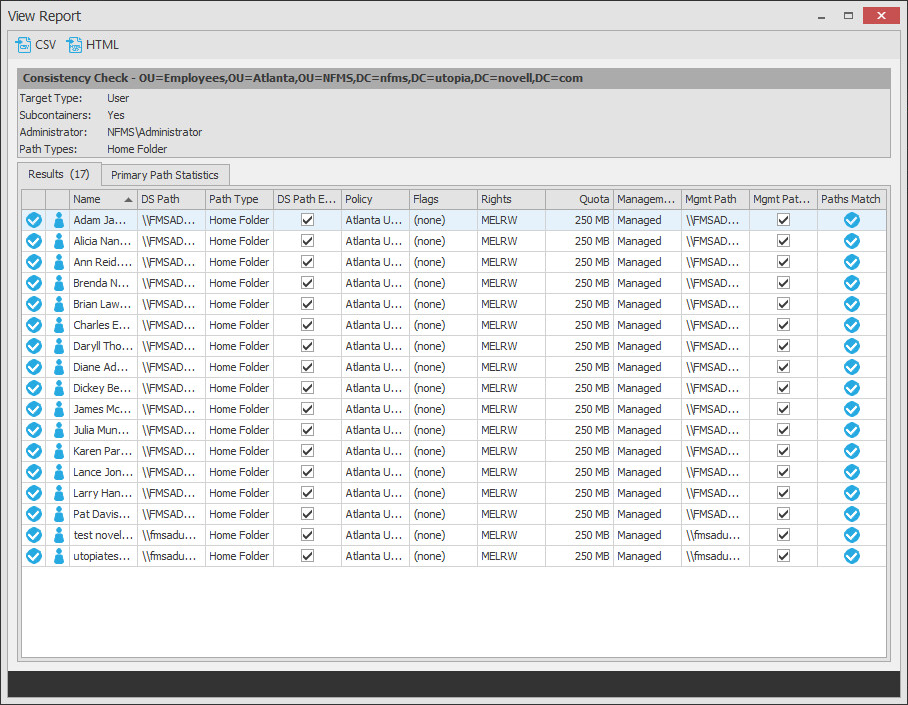
The dialog box displays the contents of the Consistency Check report.
The Primary Path Statistics tab shows the rights, flag, and path distribution data in text and graphical format.
Figure 13-33 Primary Statistics in a Consistency Check Report
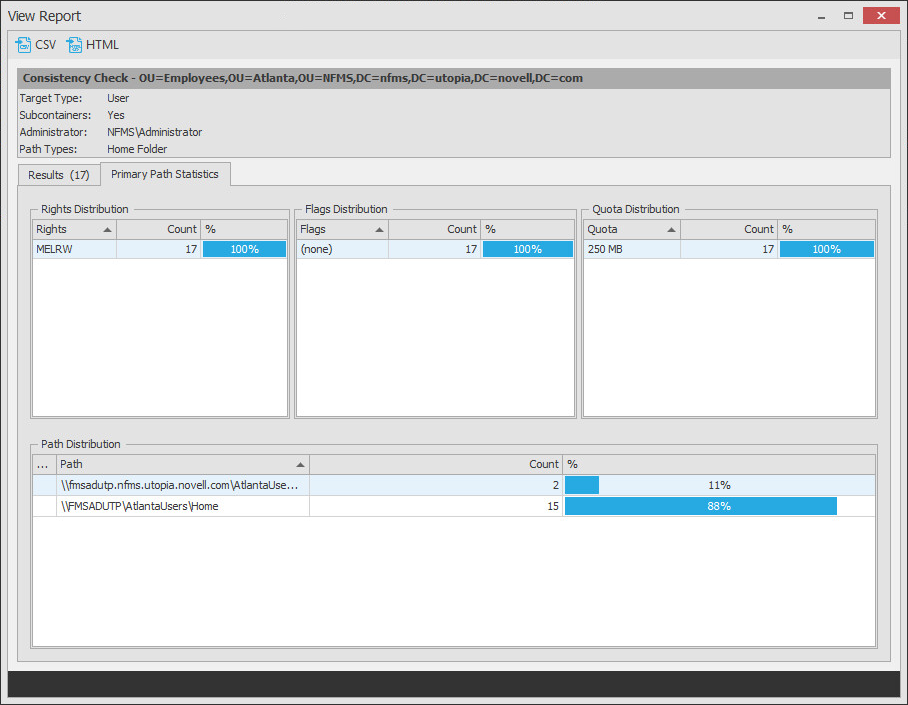
To export a Consistency Check report, double-click a report listing to access the View Report dialog box, and then in the upper-left corner of the dialog box, click either the CSV or HTML icons.
For more information on Consistency Check Reports, see Section 5.3, Running Consistency Check Reports on Existing Storage and Section 5.10, Performing a Consistency Check.
13.2.2 Actions
Action reports are stored each time a Management Action is performed. Use this page to view or export to a report, the results of any Management Action performed. A list of available Management Action reports is presented, identifying the report by the Active Directory object it was run on, and the time the report was generated.
Double-clicking any item in the list brings up the individual Management Action report.
Figure 13-34 Action Report
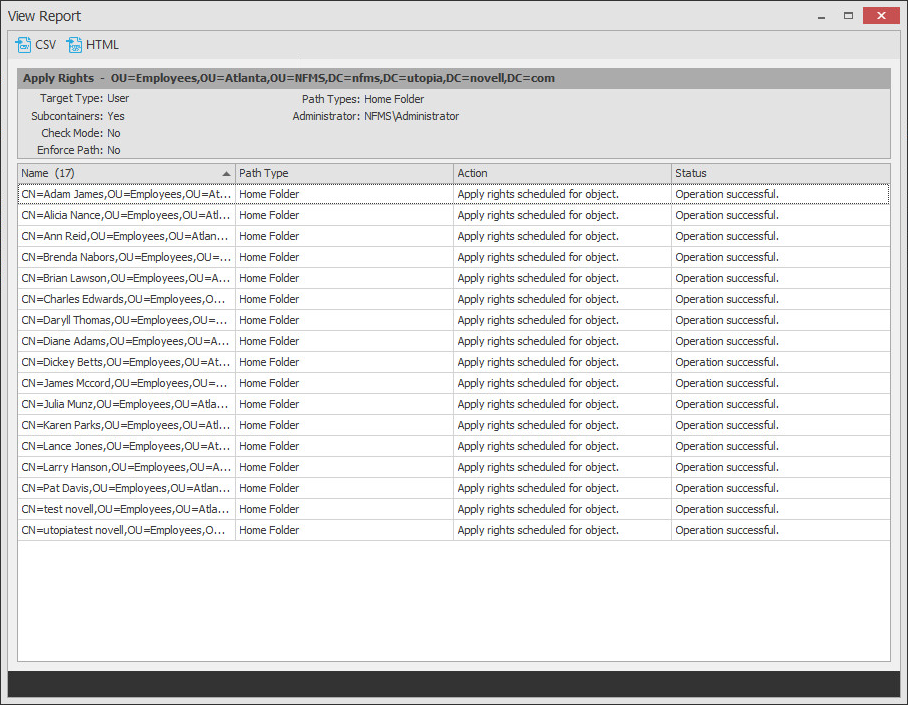
To export an Action report, double-click a report listing to access the View Report dialog box, and then in the upper-left corner of the dialog box, click either the CSV or HTML icons.
13.2.3 GSR Anomaly
The GSR Collector performs Anomaly Analysis that generates data for Anomaly Reports. These reports are designed to help you evaluate the state of your storage infrastructure. Additionally, they can be used in preparation for using Storage Manager to bring storage under management by policy. Anomaly data will be produced for each object and path type specified in the GSR Collector configuration.
Figure 13-35 GSR Anomaly Analysis
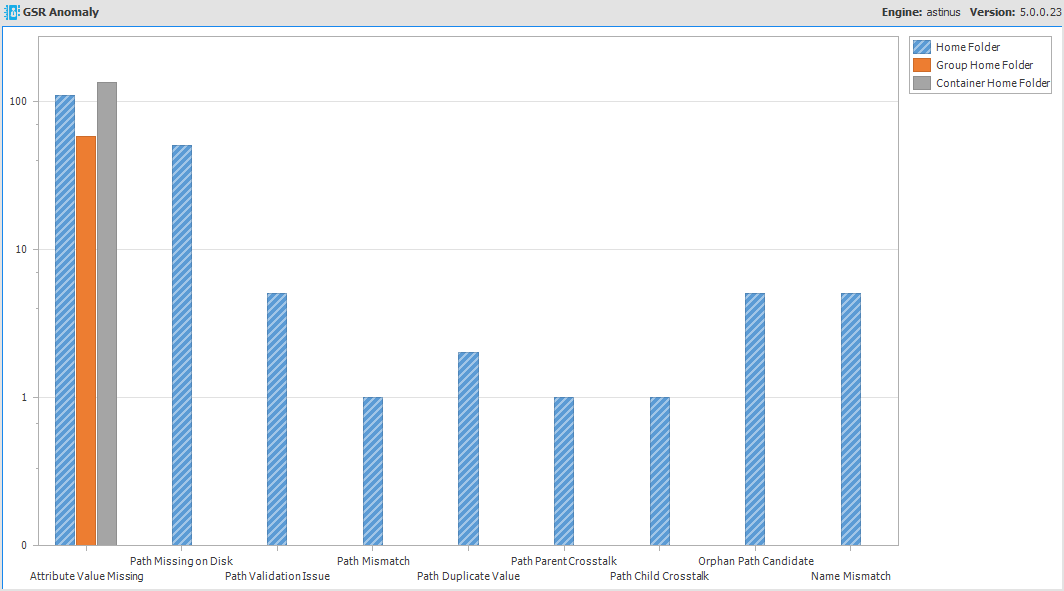
To see further detail about a specific anomaly report, single-click on the column.
A detailed summary of each of the GSR Anomaly reports follows.
Attribute Value Missing
This Anomaly report indicates that the respective path attribute (e.g. home folder) does not have a value for a given object in Active Directory.
Figure 13-36 is an example of an Attribute Value Missing Anomaly report. The Object FDN and Object SAM Account Name columns display the respective attributes. The Managed Path column does not have a value because this object is not yet managed by Storage Manager. These objects are reported because they do not have homeDirectory attribute values. This report can be used to identify objects that should be managed. It can also identify objects that have had their respective path attribute cleared accidentally or erroneously by an identity management system.
Figure 13-36 Attribute Value Missing
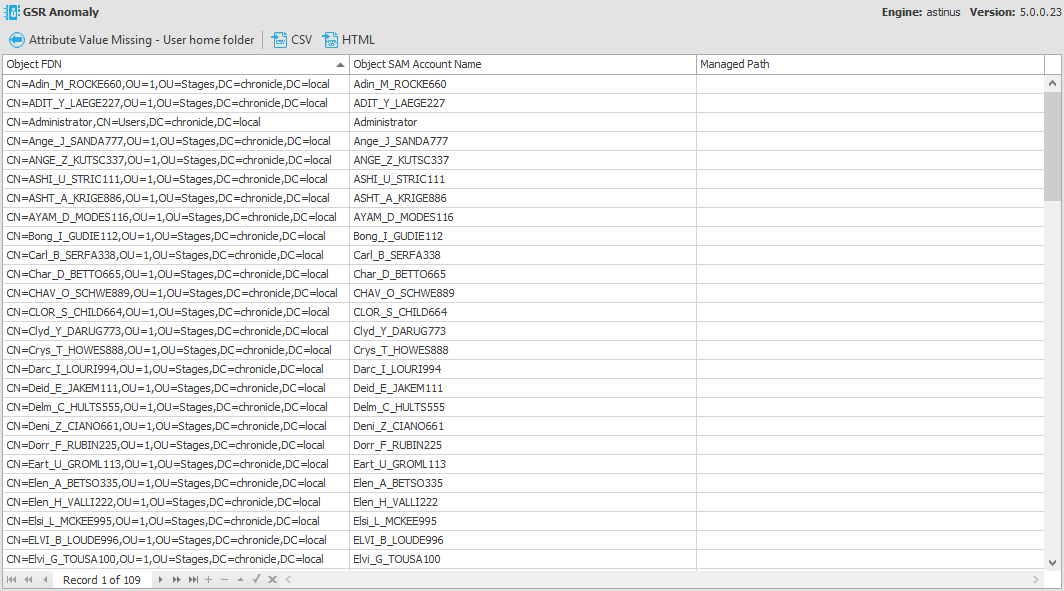
Path Missing on Disk
This Anomaly report indicates that the respective path attribute value (e.g. home folder) for a given object cannot be found on disk.
Figure 13-37 is an example of a Path Missing on Disk Anomaly report. The Object FDN and Object SAM Account Name columns display the respective attributes. The Path column is the value of the homeDirectory attribute. The Managed Path column does not have a value because this object is not yet managed by Storage Manager. This object is reported because the path specified by its homeDirectory attribute does not exist on disk or could not be found. This report can be used to identify objects whose respective path attribute value no longer exists at that location because of accidental deletion or being moved manually.
Figure 13-37 Path Missing on Disk
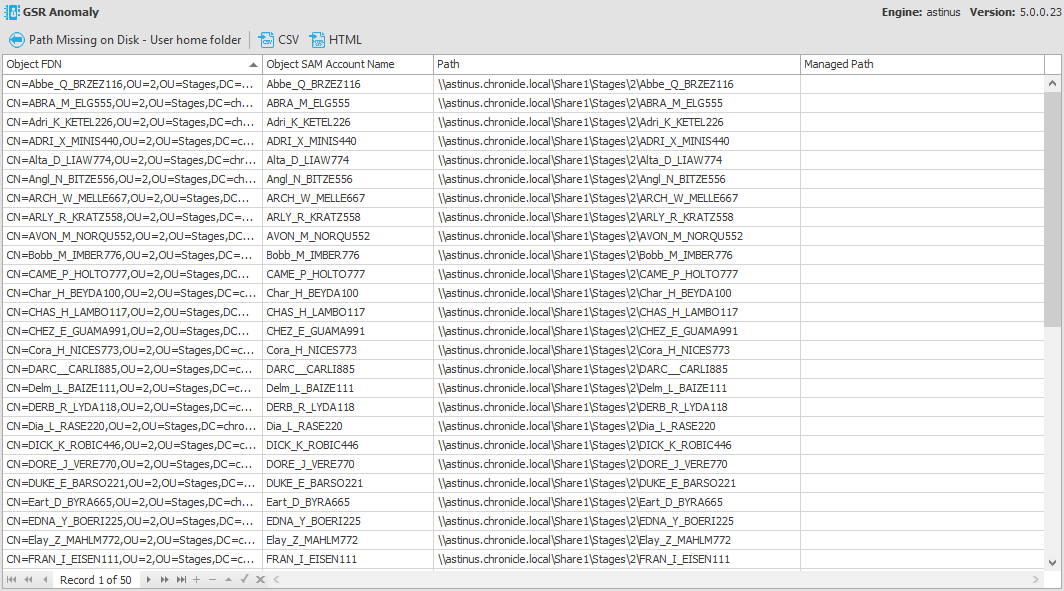
Path Validation Issue
This Anomaly report indicates that there were errors when attempting to retrieve or verify the existence of the respective path attribute value (e.g. home folder).
Figure 13-38 is an example of the Path Validation Issue Anomaly report. The Object FDN and Object SAM Account Name columns display the respective attributes. The Path column is the value of the homeDirectory attribute. The Managed Path column does not have a value because this object is not yet managed by Storage Manager. These objects are reported because there was an error when trying to verify the existence of the path specified by their homeDirectory attribute. This report can be used to identify objects whose respective path attribute value no longer exists at the specified location or if the Engine has an issue communicating with the server or share on which the path is located. The symptoms can be:
-
The share no longer exists.
-
The server is down or no longer in commission.
-
A permissions issue keeps Storage Manager from asking for the path.
-
Some other connectivity issue exists.
Figure 13-38 Path Validation Issues

Name Mismatch
This Anomaly report indicates that the leaf path name of the respective attribute value (e.g. home folder) does not match that of the respective object’s name.
Figure 13-39 is an example of the Name Mismatch report. The Object FDN and Object SAM Account Name columns display the respective attributes. The Path column is the value of the homeDirectory attribute. The Path column contains the current respective path attribute value obtained from Active Directory. The Managed Path column contains the path value when the object was last managed. This object is reported because the leaf path name specified by its homeDirectory attribute does not match the sAMAccount name attribute. This report can be used to identify objects whose respective path might have been changed manually.
Figure 13-39 Name Mismatch

Path Duplicate Value
This Anomaly report indicates that two or more objects have been detected that contain the same value for the respective path attribute (e.g. home folder).
Figure 13-40 is an example of the Path Duplicate Value report. The Object FDN and Object SAM Account Name columns display the respective attributes. The Path column is the value of the homeDirectory attribute. The Path column contains the current respective path attribute value obtained from Active Directory. The Managed Path column does not have a value because these objects are not yet managed by Storage Manager. These objects are reported because they have the same value for their homeDirectory attribute. This report can be used to identify objects who erroneously share the same path for the respective path attribute.
Figure 13-40 Path Duplicate Value

Path Parent Crosstalk
This Anomaly report indicates that the object’s respective path attribute value (e.g. home folder) has been detected as being the parent of another object’s path attribute value (e.g. home folder).
Figure 13-41 is an example of the Path Parent Crosstalk report. The Object FDN and Object SAM Account Name columns display the respective attributes. The Path column is the value of the homeDirectory attribute. The Path column contains the current respective path attribute value obtained from Active Directory. The Managed Path column does not have a value because these objects are not yet managed by Storage Manager. This object is reported because the value for its homeDirectory attribute has been detected as being the parent of another object’s homeDirectory attribute. This report can be used to identify objects whose respective path attribute is set to the wrong location and might impact another object’s storage.
Figure 13-41 Path Parent Crosstalk

Path Child Crosstalk
This Anomaly report indicates that the object’s respective path attribute value (e.g. home folder) has been detected as being the subordinate of another object’s path attribute value (e.g. home folder).
Figure 13-42 is an example of the Path Child Crosstalk report. The Object FDN and Object SAM Account Name columns display the respective attributes. The Path column is the value of the homeDirectory attribute. The Path column contains the current respective path attribute value obtained from Active Directory. The Managed Path column does not have a value because these objects are not yet managed by Storage Manager. This object is reported because the value for its homeDirectory attribute has been detected as being the child of another object’s homeDirectory attribute. This report can be used to identify objects whose respective path attribute might be impacted by another object’s storage.
Figure 13-42 Path Child Crosstalk

To see which object is a parent of this object’s homeDirectory attribute value, see Path Parent Crosstalk.
Orphan Path Candidate
This anomaly report indicates that the path is directly subordinate to a path at which other DS-associated paths have been found, but has not been detected as being associated with any DS object via a path attribute (e.g. home folder).
Figure 13-43 is an example of the Orphan Path Candidate report. The Path column is any path that is directly subordinate to a path at which other DS-associated paths have been found. However, the path is not associated with any object via a path attribute. This report can be used to identify folders that don’t belong to objects or are considered unmanaged.
Figure 13-43 Orphan Path Candidate
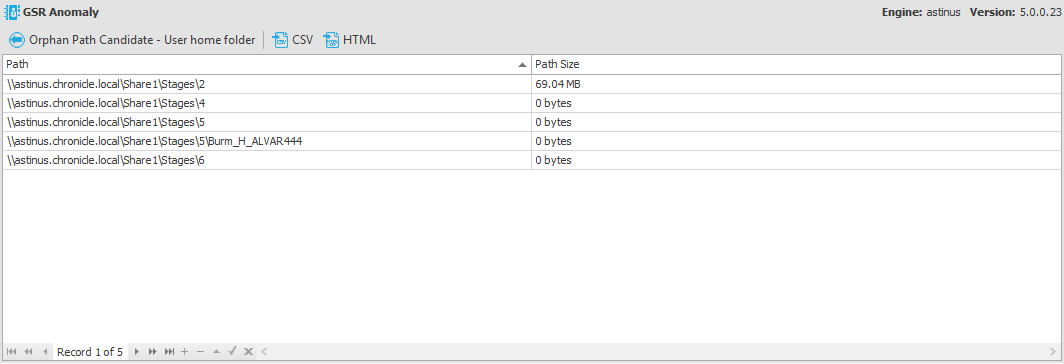
13.2.4 Completed Data Migration
This page is used to access and export stored Completed Data Migration reports.
To access a report, double-click a report listing to access the View Report dialog box.
Figure 13-44 Completed Data Migration Reports
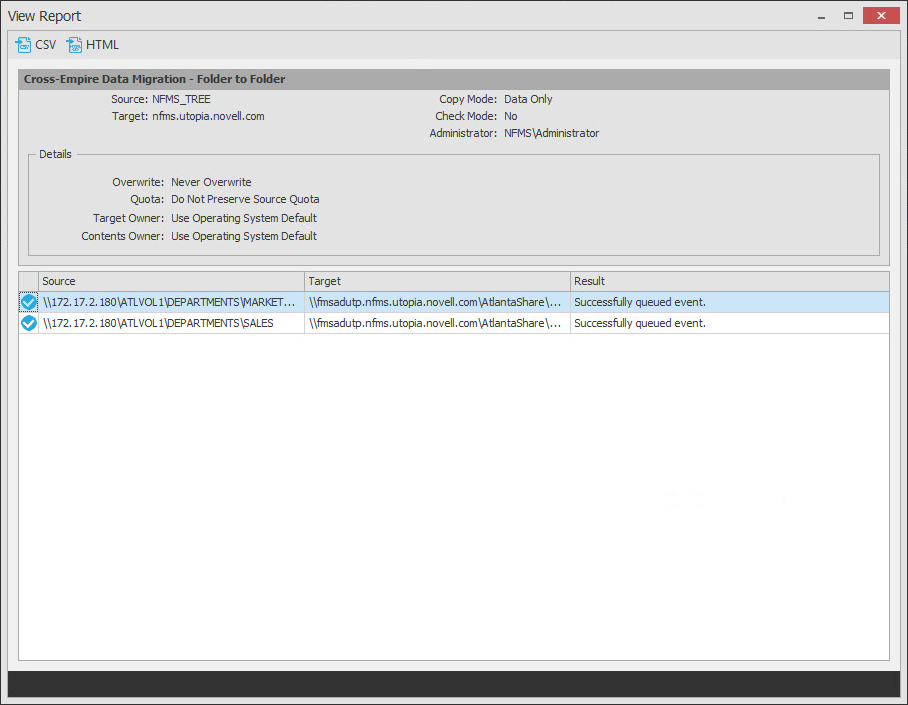
To export a Completed Cross-Empire Data Migration report, double-click a report listing to access the View Report dialog box, and then in the upper-left corner of the dialog box, click either the CSV or HTML icons.
13.2.5 Preview Source Path
This page is used to access and export stored Migration Preview reports. For more information of Migration Preview reports, see Section 10.5.7, Generating a Migration Preview Report.
To access a report, double-click a report listing to access the View Report dialog box.
Figure 13-45 Preview Source Path Report
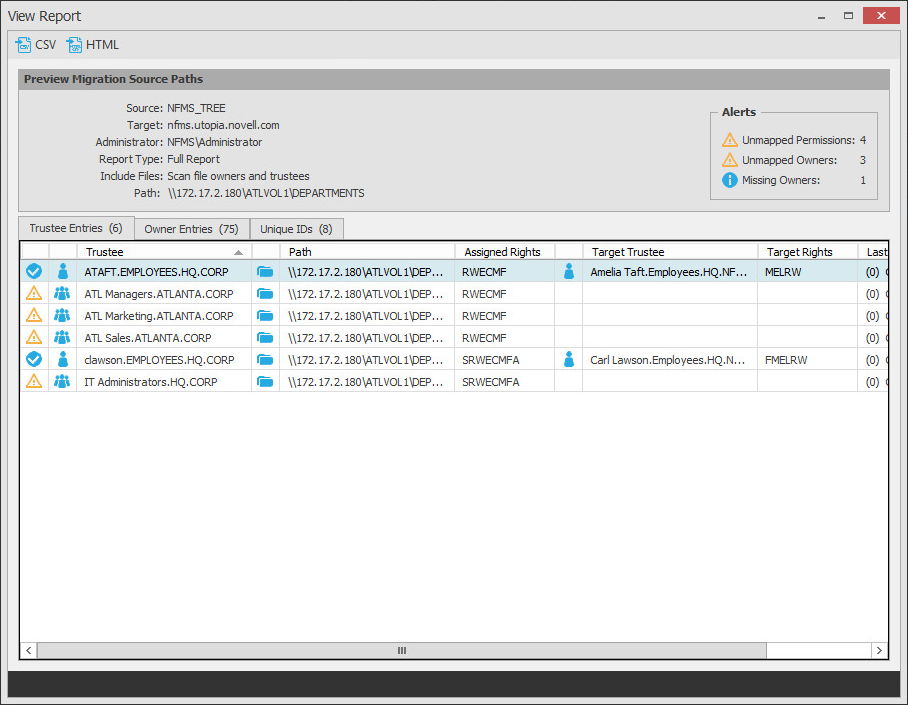
To export a Preview Source Path report, double-click a report listing to access the View Report dialog box, and then in the upper-left corner of the dialog box, click either the CSV or HTML icons.
13.2.6 Runtime Config
Runtime Config reports are used to build reports on the current configuration and pending events from the Engine. You can indicate which configuration data you want included in the report by selecting the desired check boxes.
Figure 13-46 Sample Runtime Config Report
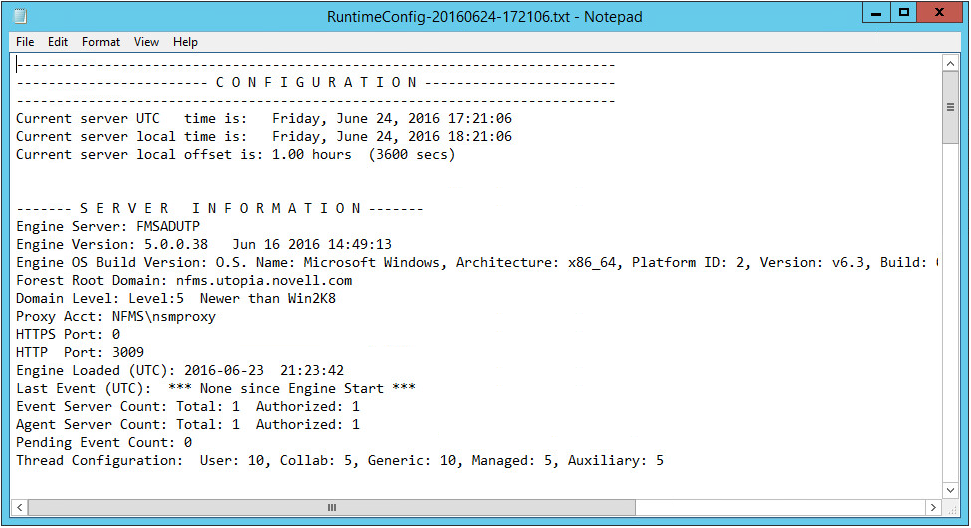
13.2.7 Policy Paths
This page shows high-level statistical information pertaining to your policies, their corresponding target paths, and size and free space information.
Figure 13-47 Policy Paths Report
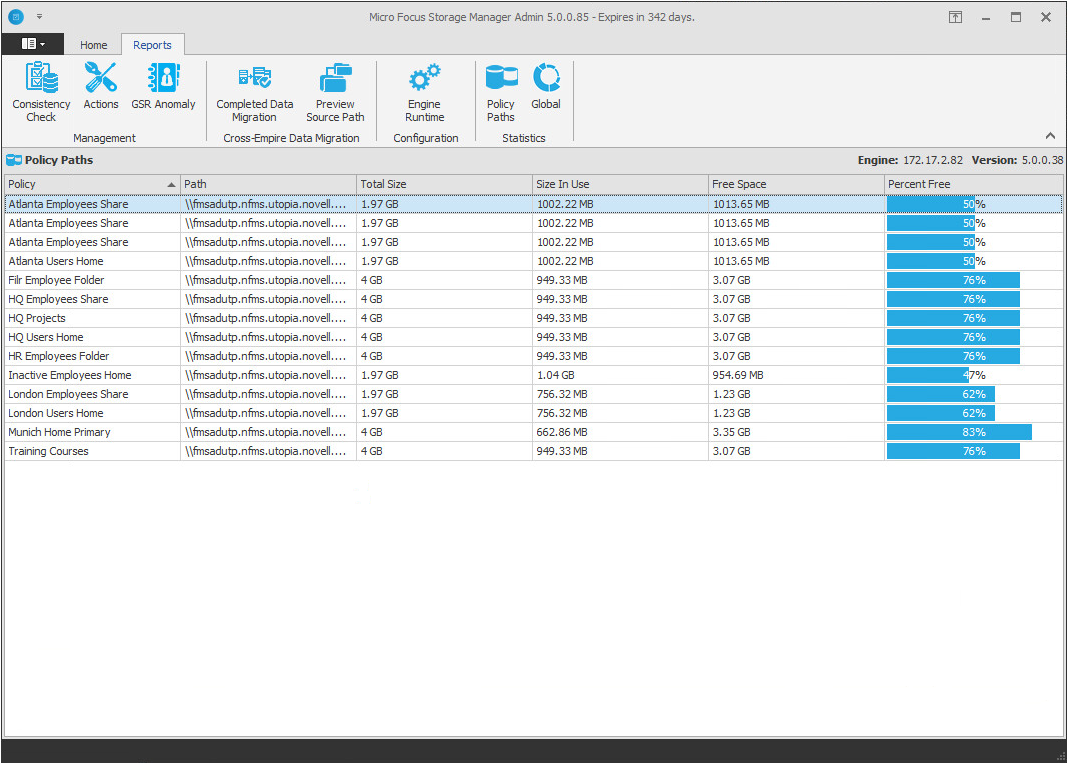
13.2.8 Global
This page provides a graphic view of the current state of your storage. The reports can be configured to show different servers, shares and paths. The class (user, collaborative, or auxiliary storage) can also be selected.
The reports can be configured to show different servers, shares and paths. The class (user, collaborative, or auxiliary storage) can also be selected. Expanding or stretching SMAdmin increases the size of the charts and the legend under each chart.
Figure 13-48 Global Report
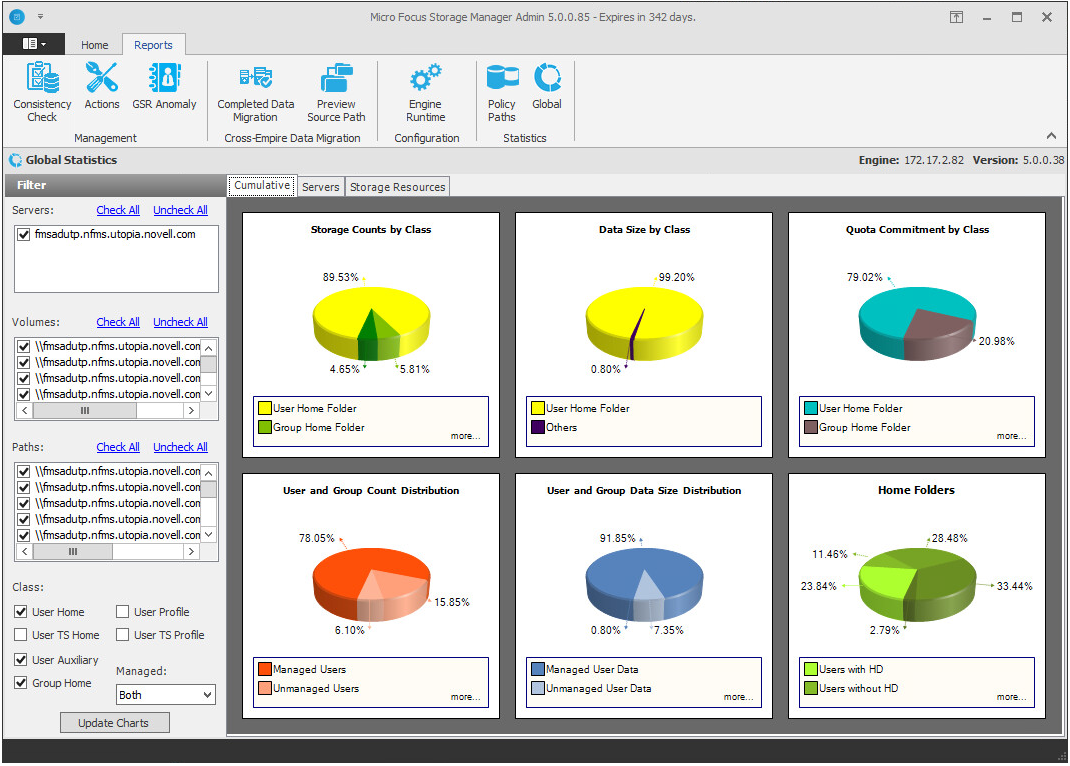
Expanding or stretching SMAdmin increases the size of the charts and the legend under each chart.
13.2.9 Configuration
Use the Configuration page to establish the Work Log reporting database settings in SMAdmin.
Work Log reporting is an optional feature introduced in Storage Manager 5.2. The Work Log database is hosted on a CouchDB database deployed either on-site or in the cloud. Once the CouchDB database has been deployed, you specify the CouchDB host system parameters in the fields on this page.
For procedures on how to set these parameters, see Section 12.3, Establishing the Work Log Database Settings in SMAdmin.
13.2.10 Reports
Use the Reports page to build Work Log Reports.
Work Log reporting is an optional feature introduced in Storage Manager 5.2. Work Log reports are built using a pivot grid interface. There are four preset options for viewing data, along with a playground option that lets you choose the parameters and presentation of the report.
For an overview of each of the report types, along with procedures for building Work Log reports, see Section 12.4, Building Work Log Reports.